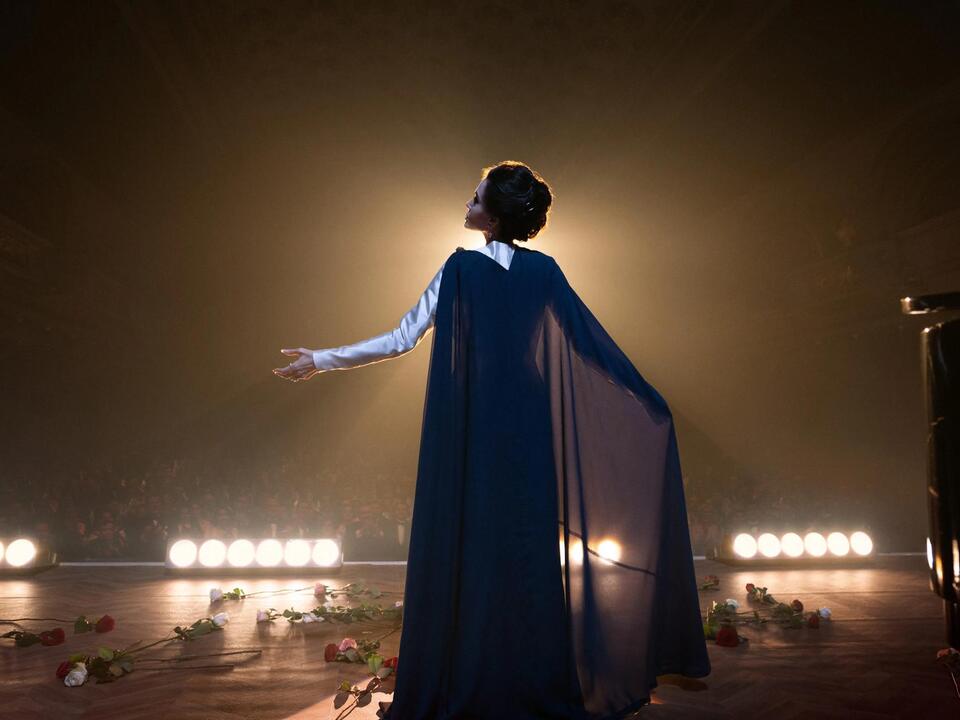Physical Address
304 North Cardinal St.
Dorchester Center, MA 02124
Physical Address
304 North Cardinal St.
Dorchester Center, MA 02124

Pablo Larraín’s drama “Maria” explores the final days of Maria Callas, the legendary American-born Greek soprano. The movie begins with the poignant scene of Maria’s death on September 16, 1977, in her opulent Paris apartment. Flashing back to a week before her demise, the narrative encapsulates a neurotic downward spiral, providing a melancholic glimpse into the life of the icon.
The luxurious apartment, replete with high ceilings, chandeliers, wooden walls, and prestigious art, evokes an 18th-century French royal court. This setting underscores a recurring theme in Larraín’s exploration of 20th-century female icons. Here, like in his previous works “Jackie” and “Spencer,” the grand residence symbolizes a gilded cage. However, Maria’s opulent Paris abode stands out as a prison crafted by its own inhabitant.
Maria’s existence has become a confinement, her days fueled by a dangerous cocktail of medication, including the hypnotic sedative Mandrax. Her eating habits are erratic, reflecting an obsessive quest to remain thin—a stark contrast to her self-perception as a “fat” girl from her past. This obsessiveness extends to her treatment of her long-term housekeeper and butler, Bruna (Alba Rohrwacher) and Feruccio (Pierfrancesco Favino), whom she dominates and directs with little regard for their comfort. The isolation is compounded by her avoidance of medical consultation and her nightly fantasies of visits from her former lover, Aristotle Onassis.
At 53, Maria Callas hasn’t performed in public for over four years. Despite this, her identity remains intertwined with her gift—a voice so extraordinary it ascends to celestial heights. Larraín fills the film with operatic masterpieces from renowned 19th-century Italian composers like Verdi, Rossini, and Puccini. Angelina Jolie’s portrayal of Callas includes meticulously lip-synced arias, capturing the essence of the soprano’s vocal brilliance. However, the haunting perfection of her recordings brings Maria pain, as she laments, “Audiences expect miracles. I can no longer perform miracles.” The decline in her vocal ability confronts her with an artistic impotence that shakes her to her core.
The film portrays the legend of La Callas—the voice that enthralled the world—as both a gift and a curse. Maria’s haunting realisation that she can no longer channel the legend leads her to question the very purpose of her existence. This narrative reverberates like a tragic opera, illustrating a great artist ensnared by the waning of her talent.
The protagonists in “Jackie” and “Spencer” faced their own trials but were depicted with an underlying strength. “Jackie” dealt with Jacqueline Kennedy’s resilience in the aftermath of her husband’s assassination, while “Spencer” depicted Princess Diana’s struggle and eventual resolve to redefine her role within the monarchy. Both films had an element of triumphant defiance.
In contrast, “Maria” is steeped in dramatic fatalism. Despite Larraín’s commendable empathy and cinematic expertise, the film’s bleakness somewhat diminishes its impact. Unlike Jackie or Diana, Maria Callas appears to be a less formidable figure, with arguably lower stakes involved in her narrative.
Angelina Jolie’s portrayal of Maria Callas is compelling. She embodies Maria with an enigmatic presence, blending the powerful allure of a diva with the vulnerability of a femme fatale. Jolie’s performance is a reminder of her capacity for serious, substantial roles, despite the film’s inability to fully explore Maria’s fragility in her twilight years.
Shot by the acclaimed Edward Lachman, “Maria” exudes a warm, autumnal visual appeal. The film uses black-and-white flashbacks to shed light on Maria’s past, adding layers of complexity that leave viewers with as many questions as answers. One thread explores her tumultuous relationship with her mother, vividly portrayed in WWII scenes.
Central to these flashbacks is Aristotle Onassis, the Greek shipping magnate Maria loved in 1959. Haluk Bilginer presents Onassis as a memorable, if not charmingly manipulative, character. Despite their intense connection, Maria’s unwillingness to fully submit to Onassis’ dominion prevented their marriage. The film even touches on Onassis’s subsequent marriage to Jackie Kennedy, adding historical context to Maria’s emotional landscape.
“Maria” has a pervasive sense of fate, which simultaneously elevates and diminishes its emotional stakes. Maria’s resolute control over her destiny precludes any last-minute redemption, leading to an inevitable conclusion. While the film offers captivating glimpses of Callas’s stage performances, these are not extended, leaving viewers desiring more profound engagement with the art that defined her legacy. As Maria herself notes, the life-draining demands of opera ultimately reflect the toll it takes—not just on the artist, but on the film portraying her tumultuous final days.
Source: Variety



